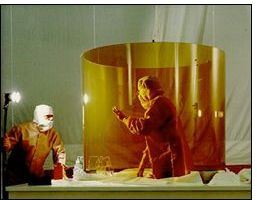Ever since 1610, when Galileo used the first telescope to discover four moons on Jupiter, astronomy has been a tinkerer's art. The equation is simple:
Cooler telescopes = hotter discoveries.
Over the past few decades, a progression of
ever-better telescopes has fostered a golden age in astronomy. Many advances stemmed
from putting telescopes in space, like the Hubble Space Telescope, to avoid the atmosphere's obscuring
effects (some people compare ground-based astronomy to watching birds from the
bottom of a full swimming pool). Other advances have come from investigating
new areas of the electromagnetic spectrum, such as the infrared or ultraviolet.
By observing X-rays from above the
atmosphere, Chandra combines both advances, providing a new peephole on weird
stuff like black holes, neutron stars and dark matter, and perhaps to the fate
of the universe itself. The name honors Subrahmanyan
(Chandra) Chandrasekhar, an Indian-American physicist whose theories
predict what will happen to stars after they run out of fuel. 
X-ray astronomy is young compared to optical astronomy (the study of stuff that
makes visible light). X-rays themselves were not discovered until 1895. In the
late 1950s, scientists at the Naval Research Laboratory began muttering about
X-rays from the stars. Wilton Sanders, an astrophysicist at the University of
Wisconsin-Madison, says the idea met a hostile reception. "The powers that
be said, 'You're out of your minds. We're not going to spend good money looking
for them.'"
One small ruse for starkind
In the face of hostility, astrophysicists
managed to gain acceptance for a plan to look for solar X-rays reflected from
the moon, on the grounds that the reflections would inform us about the moon's
surface. The ruse was fruitful. During a 1962 rocket mission that briefly
exited the atmosphere, Sanders says, "They spent only a fraction of the
time looking at the moon, and found x-rays coming from everywhere."
The field of X-ray astronomy can date its beginnings to a report on that mission. Progress accelerated with the launch of ever-better telescopes:
- 1970 Uhuru becomes the first orbiting X-ray observatory.
- 1976 The telescope that's now called Chandra is proposed.
- 1978 The Einstein X-ray observatory is launched with a resolution (ability to distinguish one thing from another) comparable to Galileo's original telescope.
- 1988 Chandra is funded.
- 1990 Rosat (the Roentgen Satellite) is launched. Rosat surveys the sky and finds 100,000 X-ray emitters. That's not bad -- but optical telescopes can see 1 billion objects.
- 1995 Rossi X-ray Timing Explorer is launched. Its hyper-accurate measurements of quick-changing X-rays emissions helps nail down the rotation of pulsars.
- 1997 Tests show that Chandra's mirrors have 10 times the resolution of Rosat and Einstein.
- 1999 Chandra is launched into an orbit that will take it one-third of the way to the moon. There will be no chance of repair; unlike the Hubble Space Telescope, Chandra must work right the first time. Want to see the most boring web-cam in history? Punch up these live and up-to-the-minute pix from Chandra's mission control!
- 2000 Europe plans to launch the X-ray Multimirror Mission, which will gather more light than Chandra. The satellite will also carry an optical telescope which will make images of the X-ray sources in visible light.
- 2000 Japan plans to launch Astro E, an E-ray telescope with, compared to Chandra, better resolution in the highest energy range.
Mirror, mirror
in the sky
With no chance to repair the telescope in space,
engineers on the $1.5 billion project skirted some of the design hassles that
faced Hubble. The physics of X-rays, however, raised enormous technical
challenges of their own. 
Since X-rays have a short wavelength, small
distortions on the mirror would cause huge errors. These boo-boos are measured
with a yardstick called the Angstrom -- one ten-billionth of a meter, or a few
times the diameter of an atom. "A rough patch only 10 Angstroms high --
1/500 the wavelength of visible light -- would look like a mountain to a
2-Angstrom X-ray and scatter it way off course," wrote Martin Elvis, head
of Chandra's science data group (see "NASA's Chandra... " in the bibliography).
To avoid a repeat of Hubble, which was,
embarrassingly enough, launched with a flawed mirror, the Chandra team
extensively tested the mirrors, which are made of glass coated with iridium.
They say the mirrors are accurate enough to read one-centimeter newspaper type
from 12 miles away (assuming anybody prints X-ray newspapers...). The
NASA crew claims that if Colorado were as smooth as Chandra's mirrors, Pike's
Peak would be 1 inch high.
These mirrors are extraordinarily smooth, and
also extraordinarily odd in appearance. That's because X-rays reflect
differently than visible light. Think of an X-ray image of a broken leg, taken
by shining a ray directly on the leg. The ray is either absorbed by the bone or
allowed to pass through the muscles undisturbed. It's not reflected.
Similarly, X-rays would be absorbed, not
reflected, by a conventional telescope mirror. But at a very shallow angle --
say 1 degree or so - the rays would reflect. Chandra's peculiar nested-lens
design takes advantage of this type of reflection, but because the bounce
barely changes the ray's direction, the distance to the detector is quite long,
explaining the telescope's 45-foot end-to-end dimension.
Chandra is long, but lean. The $1.5 billion
observatory has the light-gathering power of a 15-inch telescope - something
amateur astronomers might use here on Earth. The massive expectations for such
a midget telescope "tells you the power of the field," says
astrophysicist Richard Mushotzky of Goddard Space Flight Center. "Nature
has been very kind to X-ray astronomy."
[ TOP 10 FACTS] ABOUT [CHANDRA X-RAY OBSERVATORY ] AND [MORE ON CHANDRA]